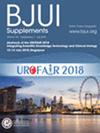Percentage of free to total PSA as a biomarker of survival in metastatic castration-resistant prostate cancer
Abstract
Objective
To analyse whether the percentage of free to total prostate-specific antigen (%fPSA) is a prognostic biomarker in metastatic castration-resistant prostate cancer (mCRPC), as novel studies suggest an elevated %fPSA is associated with adverse oncological outcomes for men with biochemical recurrence of prostate cancer.
Patients and Methods
A biobank prospectively collated at mCRPC diagnosis was analysed for %fPSA. Clinicopathological characteristics, systemic therapies and survival outcomes were recorded. Patients were stratified by a %fPSA cut-off of 15%. Cox proportional hazard models evaluated whether %fPSA was associated with overall survival (OS) and cancer-specific survival (CSS) across the cohort and by treatment.
Results
A total of 254 patients analysed with newly diagnosed mCRPC: 161 (63%) men having a %fPSA ≥15%. The median follow-up was 25.6 months. The median cohort OS and CSS was 39.6 and 43.8 months, respectively. Patients with a %fPSA ≥15% had lower median PSA level (31.30 vs 50.80 ng/mL; P = 0.007) and otherwise comparable clinicopathological and treatment profiles to men with a %fPSA <15%. Adjusting for PSA and on multivariable analysis, a %fPSA ≥15% was associated with shorter OS (multivariable hazard ratio [HR] 1.56, 95% confidence interval [CI] 1.02–2.40; P = 0.039). Among men treated with docetaxel, a %fPSA ≥15% was associated with worse OS (HR 1.84, 95% CI 1.03–3.26; P = 0.038) and CSS. Conversely, %fPSA was not associated with outcomes for men receiving androgen receptor pathway inhibitors (abiraterone acetate or enzalutamide).
Conclusion
An elevated %fPSA appears to be an adverse prognostic biomarker. Findings are consistent with biochemical recurrence studies, suggesting a biological basis. Validation and mechanistic studies are warranted.


 求助内容:
求助内容: 应助结果提醒方式:
应助结果提醒方式:


